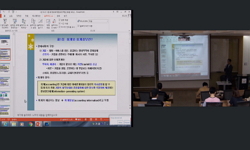This paper examined the Park Youngjin family’s accounting book(the Park’s book) to verify whether it is a double-entry bookkeeping or not. The Park’s book was recently found with records which range from 1887 to 1912. Complete records which cove...
http://chineseinput.net/에서 pinyin(병음)방식으로 중국어를 변환할 수 있습니다.
변환된 중국어를 복사하여 사용하시면 됩니다.
- 中文 을 입력하시려면 zhongwen을 입력하시고 space를누르시면됩니다.
- 北京 을 입력하시려면 beijing을 입력하시고 space를 누르시면 됩니다.

박영진家(가)의 19세기 사개송도치부 장부 회계순환 구조 = The Structure of Accounting Cycle in the 19th Century Korean Double-Entry Bookkeeping Record of the Park Youngjin Family
한글로보기https://www.riss.kr/link?id=A100493183
- 저자
- 발행기관
- 학술지명
- 권호사항
-
발행연도
2015
-
작성언어
-
- 주제어
-
KDC
300
-
등재정보
KCI등재
-
자료형태
학술저널
- 발행기관 URL
-
수록면
85-116(32쪽)
- 제공처
-
0
상세조회 -
0
다운로드
부가정보
다국어 초록 (Multilingual Abstract)
This paper examined the Park Youngjin family’s accounting book(the Park’s book) to verify whether it is a double-entry bookkeeping or not. The Park’s book was recently found with records which range from 1887 to 1912. Complete records which cover whole accounting cycle including journal entries, general ledger, and financial statements are available for nine accounting years from 1892 to 1900. The accounting year of 1894 which contains 595 transactions was investigated in line with accounting cycle. Two basic arguments applied to confirm double-entry bookkeeping are the recognition of double nature in journalizing transactions and the observance of accounting equation in individual transaction and for the accounting period. The Park’s book was also compared to modern accounting practice. This paper is the first study which examined a complete accounting book of the Sagae Songdo Chibubeob for an accounting year. Major transactions in the Park’s book were financial business of borrowing and lending and merchandising cotton textile and salt of a proprietorship. The Park``s book was confirmed to be a partial accrual-based double-entry bookkeeping that observed the double nature of transaction and maintained the accounting equation. This result provides clear evidence that the Sagae Songdo Chibubeob, the traditional bookkeeping method indigenous to Korea, is a form of double-entry bookkeeping. Since this paper examined a complete accounting book of the Sagae Songdo Chibubeob for an accounting year it is expected to conclude the long-continued debate that whether the Sagae Songdo Chibubeob is a double-entry bookkeeping or not. The result of this paper indicates that Italy and Korea are two independent origins of double-entry bookkeeping in the history of world civilization. There are, however, differences between the Park``s book and modern accounting practice. The diary, journal, and cash account of current accounting were combined into the journal in the Park‘s book. No control accounts were opened with regard to borrowing, lending, receivables, and payables. Instead, all related transactions with these accounts were recorded on individual personal accounts. Net method was adopted instead of an all inclusive approach to sales. A lump sum general administrative expense was paid in advance and adjusted to actual amount at the end of the accounting year. Net incomes from banking business and merchandising were computed separately and reported on the hoegae jimjagcho and juhoegae, respectively, as is the case of current accounting practice corresponding to segmental reporting. Income statement and statement of retained earnings were combined into one statement, hoegae jimjagcho. These differences do not violate the nature of double-entry bookkeeping. These are expected results since there were no concept regarding generally accepted accounting principle(GAAP) in the turn of the 20th century when the Park’s book was prepared. They can be construed as accounting creativity of the Park’s book. The financial statements of the Park’s book, hoegae jimjagcho and juhoegae can be converted easily into current form. This convertibility is one of the important qualitative characteristic of accounting information, so-called verifiability. Since the Park’s book is verifiable in terms of current accounting principle it is recorded obviously based on double-entry bookkeeping. The Park``s book recognized explicitly 15% of cost of equity capital as interest expense. This is the only case known which recognized explicitly cost of capital in economics, finance, and accounting. As an opportunity cost, cost of capital was conceptualized in the late 19th century, introduced to accounting in 1930’s, and used widely after 1950’s in management decision making. It is startling that the Park’s book by a Gaeseong merchant of the Joseon knew the concept cost of capital and applied it to real management in the late 19th century. Considering the argument that double-entry bookkeeping is a representative reflection of modern rationalism, the existence of the Park’s book itself is an evidence that there were capitalistic economic activities in the Joseon in the 19th century. Additional studies are possible and required to understand further Gaeseong merchant’s accounting and business practice. It is possible to ascertain the degree of influence of modern accounting to the Sagae Songdo Chibubeob by searching how accounting methods in the Park’s book were evolved. Since the Park’s book contains interest rates and prices of various goods over the period of the book recorded, these numbers can be analyzed to understand the operation of financial market and changes in price level of the Joseon in the turn of the 20th century. Analysis of ginseng field accounting included in th Park’s book is expected to provide evidence regarding cost accounting practice.
동일학술지(권/호) 다른 논문
-
수시공시수준이 재무분석가수와 회사채평가등급에 미치는 영향
- 한국회계학회
- 정명 ( Myung Jeong )
- 2015
- KCI등재
-
산업 내 선도기업의 선(先)공시이익이 후(後)공시기업의 결산일 이후 이익조정 및 시장반응에 미치는 영향
- 한국회계학회
- 두서영 ( Seo Young Doo )
- 2015
- KCI등재
-
- 한국회계학회
- 하순금 ( Soon Gum Ha )
- 2015
- KCI등재
-
- 한국회계학회
- 홍철규 ( Cheol Kyu Hong )
- 2015
- KCI등재





 KISS
KISS




